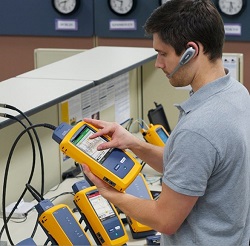Crônicas sobre cabeamento
Manter-se nunca foi tão fácil!
Keeping up with the industry is not easy. Changing standards, ways of working, technologies … Don’t worry – we have your back! We know it is sometimes hard to find the exact information you need to keep you moving forward here are some resources that will help you keep up and move ahead.
23 de maio de 2018
Quantas estrelas há no seu cinto de ferramentas?
We talk a lot about certifying copper cable plants using Fluke Networks’ DSX CableAnalyzer series certifiers, but voice, video and data deployments start with technicians having the right copper installation tools.
While Fluke Networks offers a wide range of copper and fiber installation tools designed to streamline the job and make you more productive, we thought it would be fun to take a look at our top 5 everyday copper installation tools from an Amazon.com point of view.
16 de maio de 2018
Picture Perfect AV Systems
Whether it’s video conferencing or digital signage, many of you are likely facing requests from your customers to deploy cable plants that support audio-visual systems.
9 de maio de 2018
Atualizando para o PoE de quatro pares: O que você precisa saber
Há vários anos, você executa projetos de cabos compatíveis com o padrão Power over Ethernet (PoE) para diversos dispositivos como telefones VoIP e câmeras de segurança. So far, up to 30 Watts is all you’ve been requested to support, but with the plethora of devices now able to take advantage of higher levels of PoE—like the latest 802.11ac Wi-Fi access points, digital displays and even desktop computers—your customers are starting to ask for four-pair PoE.
2 de maio de 2018
Por que não posso usar o método de teste de 2 cabos?
Like the TIA and ISO, Fluke Networks promotes the use of the 1-cord method to set reference for fiber loss measurements. The 1-cord method is where a launch cord is attached to a light source and the other end to a power meter. A reference is then set (the power measured is defined as 0 dB). Next, the launch cord is disconnected from the power meter, but not the light source. Then the far end of the launch cord is attached to the cabling under test and a receive cord between the far end of the cabling under test and the power meter.
25 de abril de 2018
Testes de cabo 101: Mas o padrão diz 0,75 dB!
We’ve covered fiber insertion loss testing in depth in many blogs, so by now you should know that it is the loss of signal that happens in a channel due to the length of the cable and any connectors, splices or splitters.
And hopefully you also know that estimating your loss budget involves adding up the loss of all of these components to make sure you’re within the loss limits specified by IEEE standards for the application you plan to run.
18 de abril de 2018
Vamos todos calibrar e nos divertir!
Just like those who drive around long after the engine service indicator lights up on the dashboard, there are folks out there who have likely been putting off getting their t

ester calibrated despite the email or LinkWare™ Live notification from Fluke Networks.
4 de abril de 2018
Muito cedo para dizer adeus? É tudo relativo...
You might remember that just about three years ago, the DTX CableAnalyzer™ was officially retired. Since its discontinuation, Fluke Networks has continued to offer technical support, repair and calibration for this tester that was once touted as the ultimate time saver and brought testing to a whole new level when it was introduced in 2004.
28 de março de 2018
Série 101: LEDs vs. VCSELs
Since today’s high-speed fiber networks use 850-nm vertical-cavity surface-emitting laser (VCSELs) transceivers, some may be confused about why light emitting diode (LED) light sources are used for testing. Understanding the differences between these two sources will certainly shed some light.
21 de março de 2018
Série 101: O que é a largura de banda modal?
Often when we hear the term “bandwidth” we think of how much data can be sent over a fiber link. But when we look at fiber specifications, we typically see a specification for modal bandwidth, or effective modal bandwidth (EMB). This key characteristic of multimode fiber refers to how much data a specific fiber can transmit at a given wavelength, and it is dependent on another characteristic—differential mode delay.
7 de março de 2018




